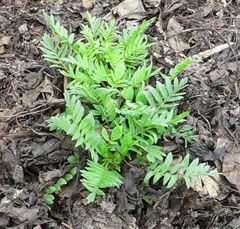Valeriana officinalis: Difference between revisions
Created page with '{{SPlantbox |Min ht metric=cm |Temp Metric=°F |image=Upload.png |image_width=240 }} {{Inc| Valeriana officinalis, Linn. Common Valerian. Garden Heliotrope. Cat's Valerian. St. G…' |
No edit summary |
||
| Line 1: | Line 1: | ||
{{SPlantbox | {{SPlantbox | ||
|Min ht metric= | |familia=Valerianaceae | ||
|genus=Valeriana | |||
|species=officinalis | |||
|common_name=Garden heliotrope, True Valerian, Valerian | |||
|habit=herbaceous | |||
|habit_ref=Wikipedia | |||
|Min ht box=16 | |||
|Min ht metric=in | |||
|Max ht box=32 | |||
|Max ht metric=in | |||
|height_ref=Flora - A Gardener's Encyclopedia | |||
|Max wd box=10 | |||
|Max wd metric=in | |||
|width_ref=Flora - A Gardener's Encyclopedia | |||
|lifespan=perennial | |||
|life_ref=Wikipedia | |||
|exposure=sun, part-sun | |||
|sun_ref=Flora - A Gardener's Encyclopedia | |||
|water=moist | |||
|water_ref=Flora - A Gardener's Encyclopedia | |||
|flowers=white | |||
|Temp Metric=°F | |Temp Metric=°F | ||
|image= | |min_zone=3 | ||
|usda_ref=Flora - A Gardener's Encyclopedia | |||
|max_zone=10.5 | |||
|image=Valeriana officinalis.jpg | |||
|image_width=240 | |image_width=240 | ||
}} | }} | ||
'''Valerian''' (''Valeriana officinalis'', [[Valerianaceae]]) is a hardy [[perennial plant|perennial]] flowering [[plant]], with heads of sweetly scented pink or white flowers. The flowers are in bloom in the northern hemisphere from June to September. Valerian was used as a perfume in the sixteenth century. | |||
Native to [[Europe]] and parts of [[Asia]], Valerian has been [[introduced species|introduced]] into [[North America]]. It is consumed as food by the [[larva]]e of some [[Lepidoptera]] ([[butterfly]] and [[moth]]) species including [[Grey Pug]]. | |||
Other names used for this plant include '''garden valerian''' (to distinguish it from other ''Valeriana'' species), '''garden heliotrope''' (although not related to ''[[Heliotropium]]'') and '''[[all-heal]]'''. The garden flower [[red valerian]] is also sometimes referred to as "valerian" but is a different species, from the same family but not particularly closely related. | |||
{{Inc| | {{Inc| | ||
Valeriana officinalis, Linn. Common Valerian. Garden Heliotrope. Cat's Valerian. St. George's Herb | Valeriana officinalis, Linn. Common Valerian. Garden Heliotrope. Cat's Valerian. St. George's Herb. Perennial, glabrous or more or less pubescent below, 2-5 ft. high: rhizome truncate, sometimes stoloniferous: sts. erect, simple below, somewhat branching above, sulcate: lvs. all pinnatisect; segms. 7-10-paired, usually dentate-serrate, those of the lower lvs. ovate-oblong, of the upper lvs. lanceolate, acuminate: corymb broadly paniculate, long-branched: fls. numerous, whitish, pinkish or lavender, very fragrant. Eu., N. Asia.—Variable. The medicinal valerian is obtained mostly from the roots of this species. Var. alba, Hort., is a white-fld. form. Var. rubra, Hort., is a red-fld. form. | ||
}} | }} | ||
==Cultivation== | ==Cultivation== | ||
Revision as of 21:53, 2 July 2010
| Valeriana officinalis subsp. var. | Garden heliotrope, True Valerian, Valerian | |||||||||||||||||||||||||||||||||||||||||||||||||||||||
|---|---|---|---|---|---|---|---|---|---|---|---|---|---|---|---|---|---|---|---|---|---|---|---|---|---|---|---|---|---|---|---|---|---|---|---|---|---|---|---|---|---|---|---|---|---|---|---|---|---|---|---|---|---|---|---|---|

|
|
| ||||||||||||||||||||||||||||||||||||||||||||||||||||||
| ||||||||||||||||||||||||||||||||||||||||||||||||||||||||
Valerian (Valeriana officinalis, Valerianaceae) is a hardy perennial flowering plant, with heads of sweetly scented pink or white flowers. The flowers are in bloom in the northern hemisphere from June to September. Valerian was used as a perfume in the sixteenth century.
Native to Europe and parts of Asia, Valerian has been introduced into North America. It is consumed as food by the larvae of some Lepidoptera (butterfly and moth) species including Grey Pug.
Other names used for this plant include garden valerian (to distinguish it from other Valeriana species), garden heliotrope (although not related to Heliotropium) and all-heal. The garden flower red valerian is also sometimes referred to as "valerian" but is a different species, from the same family but not particularly closely related.
| Standard Cyclopedia of Horticulture |
|---|
|
Valeriana officinalis, Linn. Common Valerian. Garden Heliotrope. Cat's Valerian. St. George's Herb. Perennial, glabrous or more or less pubescent below, 2-5 ft. high: rhizome truncate, sometimes stoloniferous: sts. erect, simple below, somewhat branching above, sulcate: lvs. all pinnatisect; segms. 7-10-paired, usually dentate-serrate, those of the lower lvs. ovate-oblong, of the upper lvs. lanceolate, acuminate: corymb broadly paniculate, long-branched: fls. numerous, whitish, pinkish or lavender, very fragrant. Eu., N. Asia.—Variable. The medicinal valerian is obtained mostly from the roots of this species. Var. alba, Hort., is a white-fld. form. Var. rubra, Hort., is a red-fld. form.
|
Cultivation
Propagation
Pests and diseases
Species
Gallery
If you have a photo of this plant, please upload it! Plus, there may be other photos available for you to add.
-
photo 1
-
photo 2
-
photo 3
References
- Standard Cyclopedia of Horticulture, by L. H. Bailey, MacMillan Co., 1963
External links
- w:Valeriana officinalis. Some of the material on this page may be from Wikipedia, under the Creative Commons license.
- Valeriana officinalis QR Code (Size 50, 100, 200, 500)
